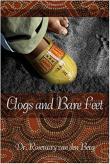AustLit
Latest Issues
AbstractHistoryArchive Description
'This book is written in three parts. The first part tells the story of my husband as a young boy growing up in Holland during the 1940s and 1950s, his migration with his family to Australia, and their return to Holland after two years. On their return, he joined the merchant navy, traveled the world, jumped ship in Sydney, and worked around Australia until he met me in Perth, Western Australia, in 1965.
'The second part tells my story of growing up in Aboriginal Australia during the 1940s and 1950s, the racist attitudes and policies, working as a nurse s aide, traveling across Australia, and returning to Perth, where I met my husband in 1965.
'The third part tells of our life together, the racism we encountered, raising our five children, traveling across the Nullabour Plain several times, moving around all the time, living in Holland, returning to Australia, me studying in adult education courses, children growing up and getting married, us becoming grandparents, and me completing my doctorate studies and retiring. I have now come out of retirement to work as an associate professor at Curtin University.' (Publication summary)
Publication Details of Only Known VersionEarliest 2 Known Versions of
Works about this Work
-
Writing Life Stories from an Aboriginal Perspective
2014
single work
criticism
— Appears in: Aboriginal Australians and Other 'Others' 2014; (p. 39-51)'During the last two decades of the 20," century, Aboriginal writers of biography and autobiography opened up new fields of literature in Australian writing. Readers have since been getting different perspectives on Aboriginal people and their lives, the untold version not previously written in the history books by the dominant society. When Aborigines write their life stories, these stories are based on their own personal experiences; the writers are being introspective or subjective. Academic writers and government researchers try to be objective when investigating Aboriginal lives, lifestyles and cultures. These research writings, from such disciplines as anthropology, come from the dominant culture's general concepts of Aboriginal people collectively, and can be biased when comparing Aboriginal lives and cultures with those from the dominant society. Aboriginal writers, in telling their life stories, express their emotions of grief and despair through loss of land and families, and the struggle to survive throughout their lives. Now it is through their literary endeavours that they are rewriting Australia's history; their input in different genres like biography and autobiography are based on the Aborigines' need to reveal another history in Australia, a black history that has been hidden. Through the writer's life experiences, the reader gains a more personalise' account of how Indigenous Australians perceive their respective land, their culture and their people. Poetry, too, like the works of Jack Davis' and Oogdgeroo of the tribe Noonuccal, helps express their innermost feelings how they see environment, which is contrary to the dominant culture's views or ideologies. However, except for David Unaipon who wrote in the 1920s, it is only in the last few decades, when more and more Aboriginal people began writing life stories, that Aboriginal literature has been accepted as a legitimate genre within Australian society. These writers give new insights into the different cultures and lifestyles Aborigines, across this country. Their readers will understand that Australia has many diverse diverse Aroriginal cultures that are very different from the dominant society's culture.'(Introduction)
-
Writing Life Stories from an Aboriginal Perspective
2014
single work
criticism
— Appears in: Aboriginal Australians and Other 'Others' 2014; (p. 39-51)'During the last two decades of the 20," century, Aboriginal writers of biography and autobiography opened up new fields of literature in Australian writing. Readers have since been getting different perspectives on Aboriginal people and their lives, the untold version not previously written in the history books by the dominant society. When Aborigines write their life stories, these stories are based on their own personal experiences; the writers are being introspective or subjective. Academic writers and government researchers try to be objective when investigating Aboriginal lives, lifestyles and cultures. These research writings, from such disciplines as anthropology, come from the dominant culture's general concepts of Aboriginal people collectively, and can be biased when comparing Aboriginal lives and cultures with those from the dominant society. Aboriginal writers, in telling their life stories, express their emotions of grief and despair through loss of land and families, and the struggle to survive throughout their lives. Now it is through their literary endeavours that they are rewriting Australia's history; their input in different genres like biography and autobiography are based on the Aborigines' need to reveal another history in Australia, a black history that has been hidden. Through the writer's life experiences, the reader gains a more personalise' account of how Indigenous Australians perceive their respective land, their culture and their people. Poetry, too, like the works of Jack Davis' and Oogdgeroo of the tribe Noonuccal, helps express their innermost feelings how they see environment, which is contrary to the dominant culture's views or ideologies. However, except for David Unaipon who wrote in the 1920s, it is only in the last few decades, when more and more Aboriginal people began writing life stories, that Aboriginal literature has been accepted as a legitimate genre within Australian society. These writers give new insights into the different cultures and lifestyles Aborigines, across this country. Their readers will understand that Australia has many diverse diverse Aroriginal cultures that are very different from the dominant society's culture.'(Introduction)




